Over the past decade, the popularity of succulents has increased dramatically. You don’t even have to go to a garden store to buy beautiful succulents as you can easily find them in grocery stores or farmers’ markets. The main reason why succulents are so popular is that they are very resilient.
Most succulents are almost impossible to kill. Moreover, despite their small sizes, their unique appearances make them focal points in any environment. Succulents can also suit any interior decor, and they can survive just as well in offices and other open spaces like they do in homes.
Among the many varieties of succulents available on the market, pastel succulents are the most popular and also our favorites. Pastel succulents will add color to your home. They are versatile and can be used in many arrangements and wall decorations.
In the following guide, we will give you some useful tips for making your succulents change color. In addition to that, we have prepared a list of the most attractive succulents that are prone to grow in pastel shades.
Tips for Getting your Succulents to Change Colour
Pastel succulents don’t have a permanent color. In fact, external factors affect their hue. In general, when succulent plants thrive, their color is brighter. On the other hand, their colors fade when they are in an improper environment. Here are the main factors that influence the color of succulents:
- Light – This is the most influential factor that affects the color of succulents. As you can imagine, the more natural light a plant will get, the more colorful it will look. However, this isn’t always the case. For example, Aloe Aristrata is naturally green but might exhibit a beautiful shade of yellow it is doesn’t get natural light. While interesting as this shade might be, it can’t be sustained for a long time. Light stress can severely damage a plant in the long run.
- Temperature and water – These factors can also affect the color of succulents. Nonetheless, playing with temperature and water is stressful for plants. You can experiment with lower temperatures and a decreased water intake. But you must check the plants’ conditions carefully. Succulents may be hard to kill, but they too have their limits.
- Soil mix – On its own, the soil is not enough to noticeably change the quality of the succulents. However, it does have a small effect and when combined with other factors, it can yield the desired results. We recommend a well-drained succulent mix with 50% inorganic matter.
Most Adorable Pastel Succulents
Narrowing down the best pastel succulents is quite a challenge as they are all pretty amazing. We’ve made a list of our favorite ones, making sure that the succulent plants on our list are as resilient as possible. So, the succulents described below won’t need much to thrive and they will reward you with their unique pink, purple, light green, and light blue hues. As you can imagine, they are the ideal desk companions and make perfect gifts for your loved ones.
Moonstones Pachyphytum
This is by far the most popular pastel succulent. The chubby leaves of Pachyphytum succulents give it a unique appearance and they are a true showstopper when they reach that intense pink shade. This plant is native to Mexico and is commonly referred to as Moonstones.
Pachyphytum is a sun-loving plant, so you should place it in the sunniest location of your home. In climates with extremely hot summers, outdoor plants need some dappled shade during hot afternoons.
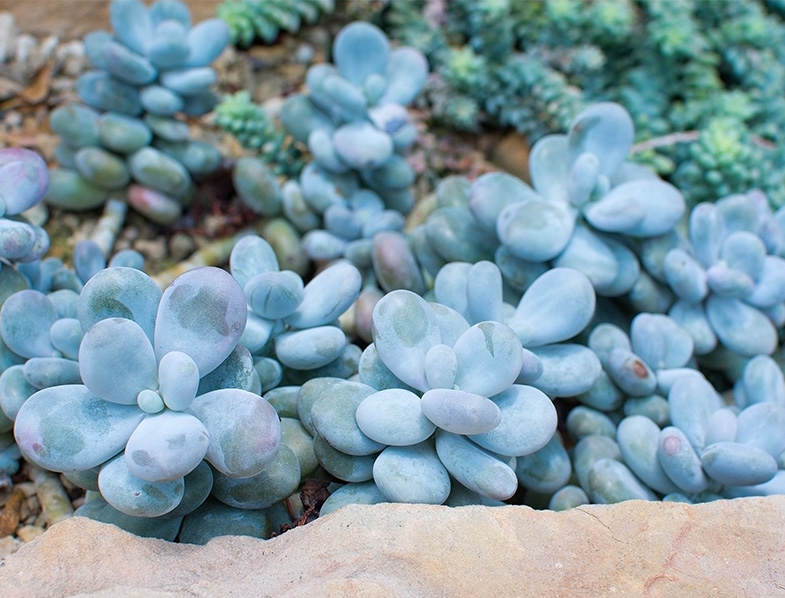
As for the soil, use a mixture of compost, sand, and pumice. This is a well-draining mixture that offers great protection for the roots. Like most succulents, Moonstone succulents thrive when the soil is allowed to dry completely before being watered.
Another important thing to remember when growing Moonstones is to keep them away from freezing temperatures. Anything below 0 degrees will hurt it, and temperatures below 6 degrees Celsius could even kill your plants.
Echeveria ‘Perle von Nurnberg’
There are many varieties of Echeveria, and several of them exhibit pastel shades. The Pearl of Nurnberg is one of the most elegant varieties. It features round, spoon-shaped leaves with pointy tips, displayed in a concentric manner.
Depending on the environmental factors, the rosette of leaves can change colors from pink to a grey-ish blue and it can even display hints of purple. It can reach a top height of 13 cm and a maximum spread of 16 cm.
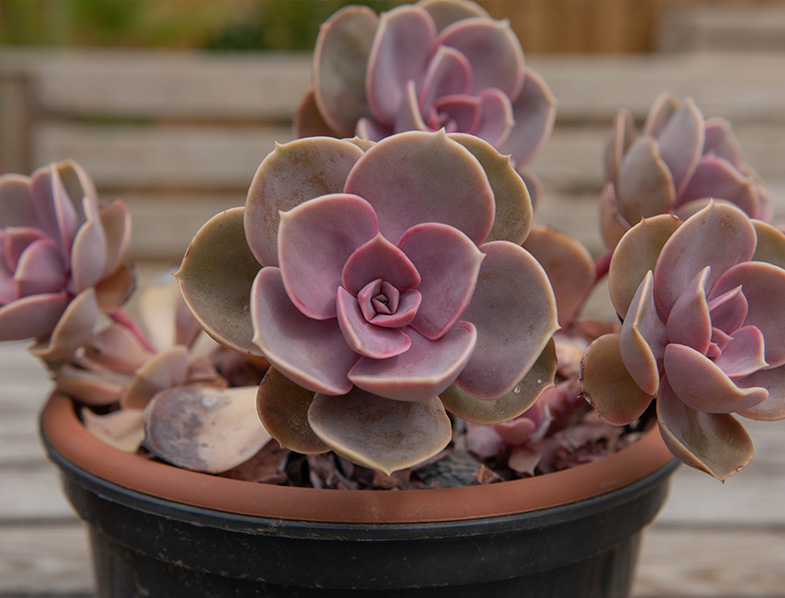
While the beauty of this plant is given by its leaves, it is even more enhanced during summer and autumn, when it grows pink and yellow flowers.
This plant thrives in full sun, although it can also grow quite well in partial sun. It doesn’t need any fertilizer and it is very easy to propagate. It likes the soil to dry completely between watering sessions. However, when you do water it, make sure to soak it well, allowing it to absorb as much moisture as it needs.
Sedum Nussbaumerianum
Also known as Coppertone Sedum or Coppertone Stonecrop, this is a low-growing perennial. It has attractive succulent leaves displayed in a rosette pattern. It can be grown both indoors and outdoors.
In fact, this type of Sedum grows better if it also gets some outdoor time, where it can get exposed to natural elements. But, to be on the safe side, you should bring it indoors during harsh winters.

Coppertone Sedum is native to Mexico and is suitable for USDA zones 9a to 11b. Indoors, it can suit most design styles, and outdoors it looks great in Mediterranean gardens and desert gardens.
This plant can grow just as well in partial shade as it will in full sunshine. The amount of light it gets will affect its color. In partial shade, it will be a yellowish shade. However, it is the copper shade that makes this plant more interesting, and that shade can only be obtained if the plant gets plenty of sunshine.
Lack of sunshine doesn’t just affect the plant’s color, but also its appearance. In an effort to get more sunshine, the sedum plant will get leggy. Outdoors the plant grows better in partial sunlight. Whenever you move your plants to a new location, be it outdoors or indoors, it is important to give them time to acclimatize to the new space. This way, they adjust to the changes in the amount of light that they gets.
Echeveria Rusbyi
Like all Echeverias, the Rusbyi variety has plump leaves that grow in a concentrical pattern. As opposed to the Pearl of Nurnberg, the Rusbyi variety has thicker and smaller leaves with tips as pointy that needle tips.
Echeveria Rusby grows up to 10 cm in diameter, featuring 5 cm leaves. It is also known as Leatherpetal and it usually grows in clusters of rosettes. The color of its leaves can change from blue-green to dusty pink. Obviously, the warmer shades are achieved when this succulent gets plenty of sunshine. When in bloom, it features white to yellow star-shaped flowers.
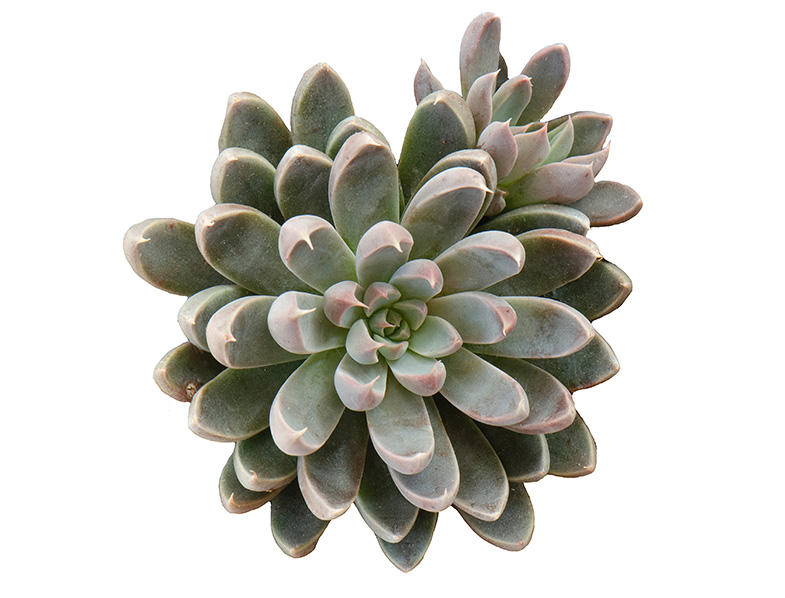
Outdoor, Echeveria Rusby is suitable for warm climates, but it makes for a great houseplant in most parts of the world. It needs well-drained soil and it can make do with very little water. This is a true survival plant that can adapt to both shade and full sun. Fertilizing is not necessary, but it can give the plant a growth boost. Use a balanced fertilizer and dilute it to ¼ of its strength. Only fertilize during the growing season.
Echeveria Laui
Like most Echeveria plants, the Laui variety features a rosette of color-changing leaves. Unlike the previously mentioned Rusbyi variety which grows in clusters, the Laui variety has one main rosette. Its leaves are also rounder and less pointy than other varieties. It grows up to 20 cm in height. It is important to mention that this succulent is a slow grower so it takes many years for it to reach its mature size. It blooms several times per year, and if it thrives in its environment, it grows pink-orange flowers.
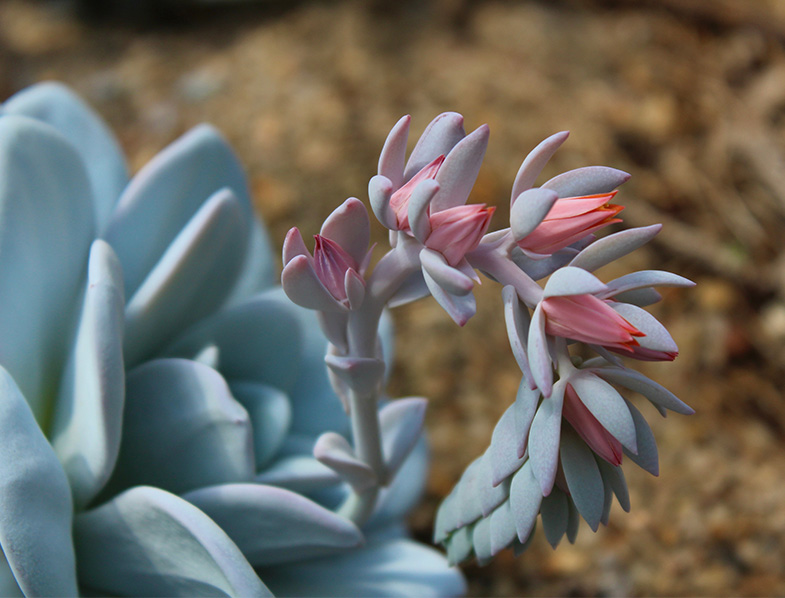
In normal conditions, the leaves of Echeveria Laui have a dusty blue shade. However, when it is exposed to plenty of sunshine it reaches a soft pink color. An interesting shade can be achieved when the plant transitions from a shady spot to a sunnier location. The leaves change color starting from the edges, so until they get fully pink, you can obtain a rainbow effect. It can have different shades of pink towards the edges and a blue-green shade towards the center of the leaves. Be wary as sudden sunlight changes might stress the plant. You should also try to protect the plant from the intense afternoon sun.
Sedum Spathulifolium
This is a more unusual succulent that grows several short plump stems, each one featuring a single rosette of spoon-shaped leaves. Depending on the amount of sunshine that they get, the leaves can have a powdery blue shade or they can turn pink. Some varieties can even achieve a deeper purple shade when exposed to sufficient sunlight. It reaches an average height of 10 cm with a top spread of 60 cm. In shadier locations, it can get leggy, with the stems spilling over the container edges.
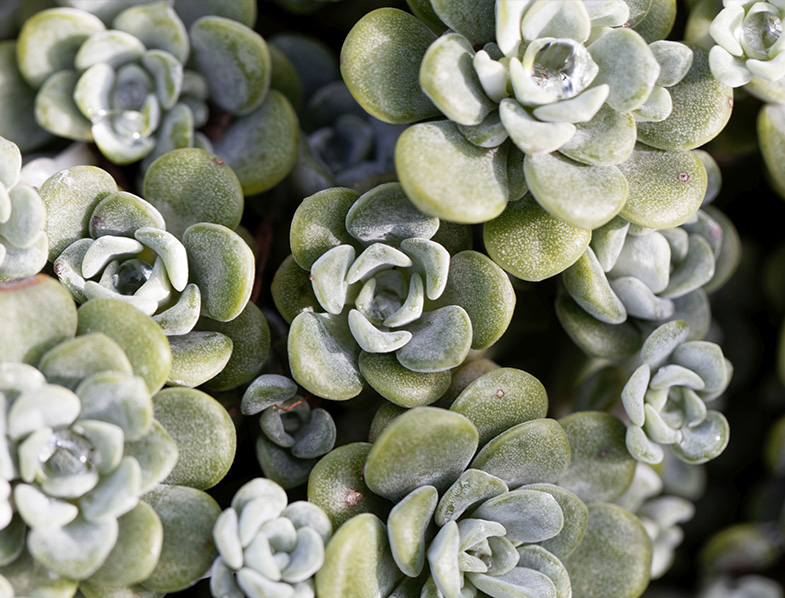
Sedum Spathulifolium is very hardy and it needs a minimum amount of water. You must plant it in well-drained soil and allow the soil to thoroughly dry between watering sessions. The water should be applied to the root zone. Moist foliage should be avoided because it can encourage the development of pests and diseases. Soaking is also a good way to water Sedum Spathufolium. Pruning is not necessary, but removing old stems will keep the plant more focused on new growth.
Graptopetalum Superbum
Like most succulents, this plant is native to Mexico. It can grow up to 30 cm in height and it can reach a top diameter of 60 cm. The primary color of its leaves is pink, but the more sunlight it gets, the darker the leaves get, reaching lavender or even purple shades.
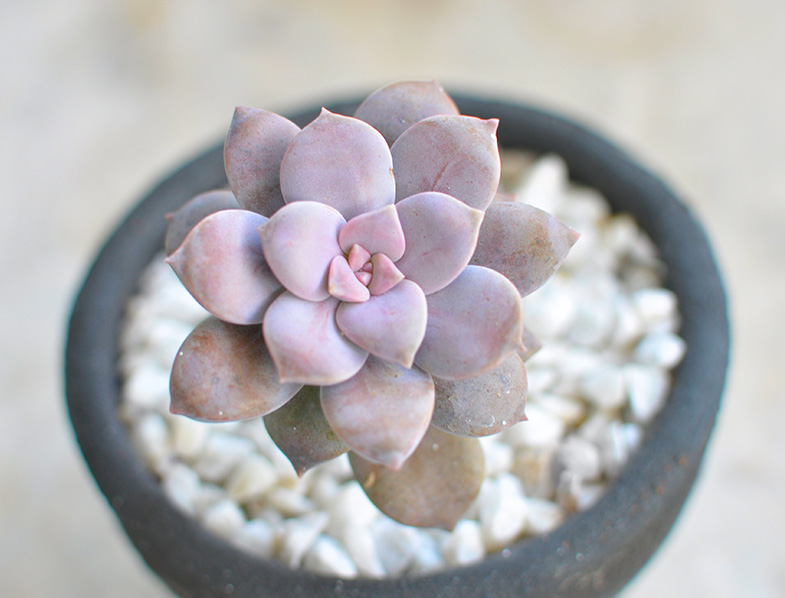
The leaves feature a powdery coating and they grow in a rosette pattern. The stems can leggy, especially when you have a cluster of several flowers, fighting for sunshine. Leggier stems will start upright, but as they grow, they succumb to the weight of the rosette and cascade over container edges.
Graptopetalum succulents are generally disease-free, but they can be bothered by some pests like aphids or mealybugs. These succulents like sandy, well-drained soil and can grow in light shade or full sun. During springs it produces yellow flowers with red markings. For the best results use a soil mix with 50% to 70% mineral grit.
Crassula Rupestris
This succulent plant is mainly green, but we like the fact that it usually features a very light pastel green shade with darker edges. In some varieties, the top rosettes feature pink edges. The interesting thing about this succulent is that while it grows on stems, the stems are entirely covered by leaves.
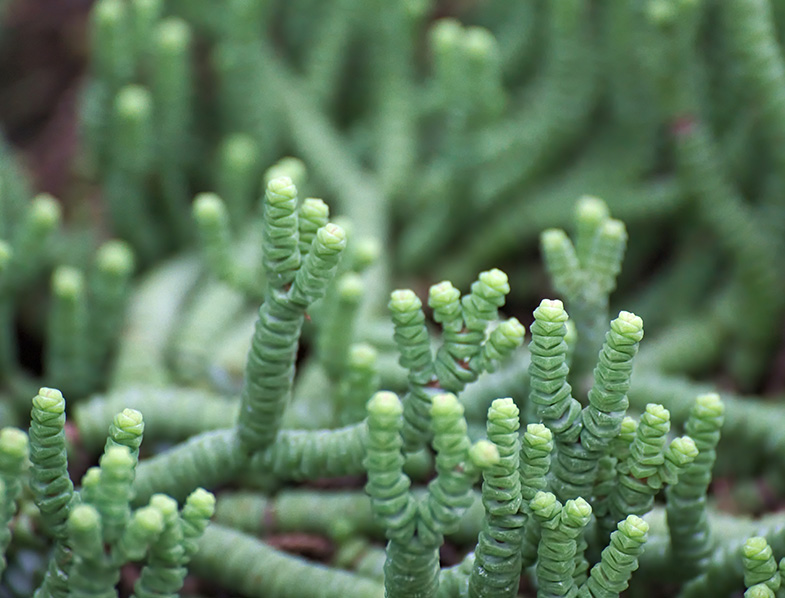
The stems are woody at the base but fleshy at the tip. The leaves are triangle-shaped. They grow on levels with two opposing leaves on each level. Like most succulents, it is suitable for USDA zones 9b to 11b.
Crassula Rupestris is a very hardy plant as long as you ignore it most of the time. It likes to be watered infrequently and it needs the soil to dry between watering sessions. While this plant is very resilient, over-watering can cause fungal diseases. Mealybugs can also be an occasional problem.
Conclusion
Most succulents are hardy and easy to grow. The less you worry about them, the more they will thrive. Keep in mind that sunlight is important in order to achieve lovely pastel shades. Experimenting with different sun exposures can be tricky but if you get the hang of it, you can achieve a wider variety of pastel shades and even rainbow combinations.
Last but not least, keep in mind that succulents look best when you grow them in large numbers. Whether you plant them in distinct containers or you combine them in living art decorations, succulents will add joy and color to your home. Growing pastel succulents can be very rewarding, and don’t be surprised if you turn into an enthusiastic succulent collector once you’ve mastered the art of succulent growing.
Are you growing pastel succulents? Let us know what your favorite types are!
